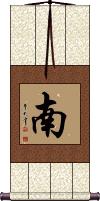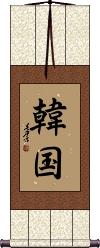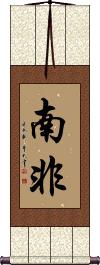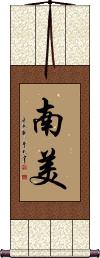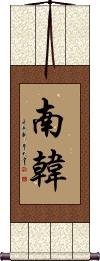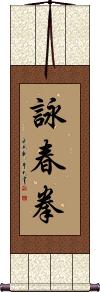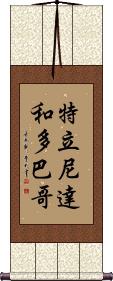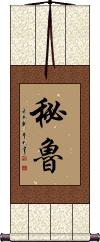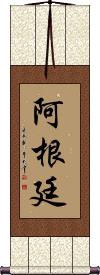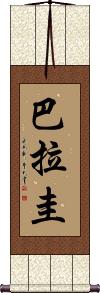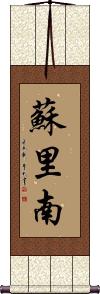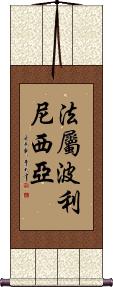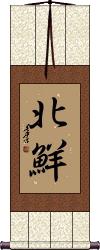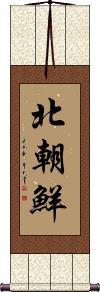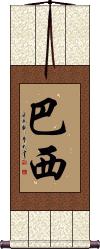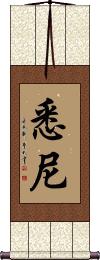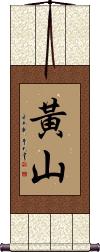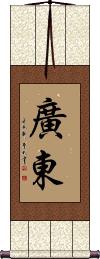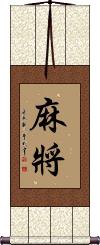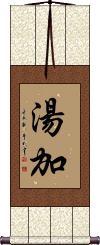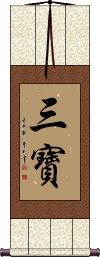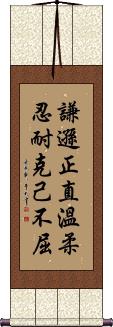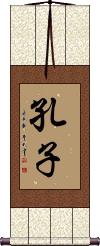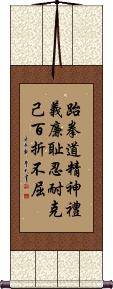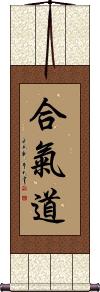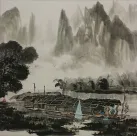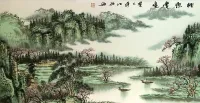Many custom options...
And formats...

Nan South in Chinese / Japanese...
Buy a Nan South calligraphy wall scroll here!
Personalize your custom “Nan South” project by clicking the button next to your favorite “Nan South” title below...
1. Nan / South
2. South Africa
3. South Korea
4. South Africa
6. South Korea
9. Aruba
10. Peru
11. Argentina
12. Guyana
13. Paraguay
14. Suriname
15. Uruguay
16. Bolivia
17. Colombia
18. Ecuador
19. Venezuela
20. French Polynesia
21. North Korea
22. Faroe Islands
23. North Korea
24. Brazil
25. Sydney
26. Huang Shan / Yellow Mountain
27. Hwacheon
29. Mahjong
30. Tonga
31. Easter
33. Bodhidharma
34. Three Treasures of Buddhism
35. Longevity / Long Life Wishes
37. Confucius
39. Taekwondo Tenets / Spirit of Taekwon-do
40. Hapkido
Nan / South
南 means south or southern.
In Chinese, this is also a surname that romanizes as Nan.
In Japanese, it can also be the given names Mimi, Minamihama, Minamitate, Minami, Mina, Miumi, Hinata, Nantetsu, or Namuchoru. It can be the Japanese surnames Nanzaki, Nan, Namu, Nami, or Takaminami.
South Africa
South Korea
South Africa
South America
South America
South Korea
南韓 is the common Chinese name for the country of South Korea.
The official English name being Republic of Korea.
See Also: North Korea | Asia
Wing Chun Fist
詠春拳 is the title for the “Wing Chun” school of martial arts but with the addition of the character for “fist” at the end. So this is “Wing Chun Fist” or literally “Singing Spring Fist.”
There are lots of alternate Cantonese romanizations for this, such as “Wing Chun Kuen,” “Wing Tsun Cheun,” “Eng Chun Pai,” and “Wing Ceon Kyun.” The characters are the same; just the lack of a standard Cantonese romanization means that people make up their own based on what they think it sounds like.
Trinidad and Tobago
This is the Chinese name for the country of Trinidad and Tobago.
Definitions vary as to whether in North or South America.
See Also: North America | South America
Aruba
阿魯巴 is the Chinese name for the territory of Aruba (overseas country in the Kingdom of the Netherlands).
Note: Definitions vary as to whether Aruba is in North America or South America.
See Also: Netherlands | North America | South America
Peru
Argentina
Guyana
Paraguay
Suriname
Uruguay
Bolivia
Colombia
Ecuador
Venezuela
French Polynesia
This is the Chinese name for French Polynesia (overseas territory of France).
See Also: South America
North Korea
This short Japanese name for the country of North Korea (Democratic People's Republic of Korea).
There is a 3-character name, 北朝鮮 that is a lot more common.
See Also: South Korea | Asia
Faroe Islands
法羅島 is the Chinese name for the country of the Faroe Islands (overseas territory of Denmark).
See Also: Denmark | South America
North Korea
北朝鮮 is the Chinese and Japanese name for the country of North Korea.
The official English name being Democratic People's Republic of Korea.
See Also: South Korea | Asia
Brazil
Sydney
Australian city
Huang Shan / Yellow Mountain
Hwacheon
Canton / Guangdong
廣東 is the title of Guangdong province (Kwangtung) in south China.
In English, this place is also known as Canton, and is the root of the word Cantonese for the language, culture, and cooking style of this region.
Beyond Canton, this can be the surname Hirotou or Hiroto in Japanese though often written in the modern form of 広東 in Japan.
Mahjong
Tonga
This is the Chinese name for the country of Tonga.
While this is the name of that south Pacific archipelago kingdom in Chinese, it does not mean the same in Japanese...
In Japanese, this is a female given name Yuka. There are several female names that romanize as Yuka, so be sure you get the right one.
See Also: Oceania
Easter
復活節 is the Chinese and old Korean way to write Easter.
Easter is not a well-known holiday in China, but Chinese Christians tend to follow the American tradition of the Easter egg ritual, etc. Non-Christians may think it's a celebration of rabbits that can lay eggs.
South Korea has a higher percentage of Christians than any other Asian country, so they celebrate Easter with plenty of enthusiasm.
Shakyamuni / The Buddha
釋迦牟尼 is a transliteration of “Shakyamuni” or “Sakyamuni” in Chinese, Japanese, and old Korean.
The perceived meaning of the name is roughly translated as “Sage of the Sakyas.”
This same Buddha is also known as “Siddhartha Gautama,” “Gotama Buddha,” “Tathagata,” or simply, “The Supreme Buddha.”
Shakyamuni is the legendary man and prince who eventually established the Buddhist religion.
Note: Occasionally Romanized as “Siddhattha Gotama.”
This combination of characters is sometimes seen and used in South Korea and Japan as well (with the same meaning).
Note: 釋迦牟尼 came from the Sanskrit शाक्यमुनि and can also be romanized with diuretics as Śākyamuni.
Bodhidharma
菩提達磨 is the title Bodhidharma in Chinese and Japanese.
Bodhidharma, commonly known as Damo, is reputed as the founder of the Chan (Zen) or Intuitional or Mystic School.
He likely came from south India and spread Mahayana Buddhism throughout China (even meeting the Emperor) and his disciples likely spread this all the way to Korea, Japan, and beyond in the 5th and 6th centuries.
Sometimes the last character varies in Chinese to 摩 instead of 磨 - let me know if you need a certain variation when you order.
Three Treasures of Buddhism
The Triple Gem
三寶 is the title for “Three Precious Treasures of Buddhism” or “The Triple Gem.”
These three treasures are the Buddha 佛, the Dharma 法 (teachings or the law of the Buddha), and the Sangha 僧 (the community of monks or followers).
This term is used by most (perhaps not all) Buddhists in China, Japan, and South Korea (written the same in the original form but pronounced differently in each language). Non-Buddhists may just read this as “Three Treasures” without the religious context. For instance, there is also a “Three Treasures of Chinese Medicine” that is sometimes titled the same way.
In modern Japanese and Simplified Chinese, this is written 三宝 instead of 三寶.
Longevity / Long Life Wishes
南山之壽 is a wish for long life for someone. The first part of this Japanese phrase is “Nan Zan,” which means “south mountain.” This mountain is one of the good wishes, good fortune, and prosperity. The title is often used as a salutation of good wishes.
The third Kanji is just a connector, and the last Kanji means long life or longevity.
I guess you could translate this phrase as “May your life be as long as Nan Zan is tall.”
Korean CKD Virtues
谦逊正直温柔忍耐克己不屈 are the virtues used by Choi Kwang Do Martial Arts.
| English | Hanja | Hangul | Pronunciation |
| 1. Humility (Humble / Modesty) | 謙遜 | 겸손 | gyeom son |
| 2. Honesty (Integrity) | 正直 | 정직 | jeong jig |
| 3. Gentleness | 溫柔 | 온유 | on yu |
| 4. Perseverance (To Endure) | 忍耐 | 인내 | in nae |
| 5. Self-Control (Self-Restraint) | 克己 | 극기 | geug gi |
| 6. Unbreakable Spirit (Unyielding / Unbending) | 不屈 | 불굴 | bur gur |
The characters shown here are in the ancient Korean Hanja form of writing. If you wish for a Korean Hangul form of these tenets, we can arrange that with our Master Calligrapher Xing An-Ping (click on the Hangul next to the South Korean flag above to order this in Hangul).
Confucius
孔子 is how to write the name of the great sage, known in the West as Confucius.
His real name is Kongzi (The name Confucius is a westernized version of his name - his family name is Kong, and “zi” was added as a title of distinction).
He lived some 2500 years ago in Qufu, a town in modern-day Shandong Province of Northern China (about 6 hours south of Beijing by bus). He was a consort to Emperors, and after his death, the impact of his philosophies still served to advise emperors, officials, and common people for generations.
Also during these thousands of years, the Kong family remained powerful in China, and the Kong estate was much like the Vatican in Rome. The Kong estate existed as if on sovereign ground with its own small garrison of guards and the privileges of a kingdom within an empire.
This was true up until the time the Kong family had to flee to Taiwan in 1949 when the Red Army took victory over the Nationalists during the Revolution. The home of Confucius was later razed and all statues were defaced or stolen during the Cultural Revolution. Finally, after years of smearing his name and image, it is once again okay to celebrate the teachings of Confucius in mainland China.
Known as Khổng Tử in Vietnamese.
Body and Earth in Unity
身土不二 (Shindofuni) is originally a Buddhist concept or proverb referring to the inseparability of body-mind and geographical circumstances.
This reads, “Body [and] earth [are] not two.”
Other translations or matching ideas include:
Body and land are one.
Body and earth can not be separated.
Body earth sensory curation.
You are what you eat.
Indivisibility of the body and the land (because the body is made from food and food is made from the land).
Going further, this speaks of our human bodies and the land from which we get our food being closely connected. This phrase is often used when talking about natural and organic vegetables coming directly from the farm to provide the healthiest foods in Japan.
Character notes: 身(shin) in this context does not just mean your physical body but a concept including both body and mind.
土 (do) refers to the soil, earth, clay, land, or in some cases, locality. It's not the proper name of Earth, the planet. However, it can refer to the land or realm we live in.
Japanese note: This has been used in Japan, on and off, since 1907 as a slogan for a governmental healthy eating campaign (usually pronounced as shindofuji instead of the original shindofuni in this context). It may have been hijacked from Buddhism for this propaganda purpose, but at least this is “healthy propaganda.”
Korean note: The phrase 身土不二 was in use by 1610 A.D. in Korea, where it can be found in an early medical journal.
In modern South Korea, it's written in Hangul as 신토불이. Korea used Chinese characters (same source as Japanese Kanji) as their only written standard form of the language until about a hundred years ago. Therefore, many Koreans will recognize this as a native phrase and concept.
See Also: Strength and Love in Unity
Taekwondo Tenets / Spirit of Taekwon-do
跆拳道精神禮義廉耻忍耐克己百折不屈 is General Choi's writing that is often called “The Tenets of Taekwon-do.”
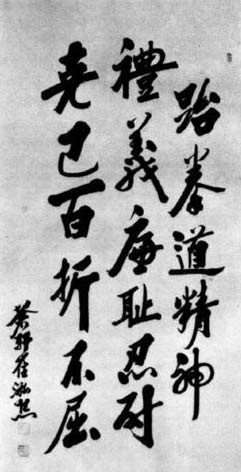
The actual title would be translated as “Taekwondo Spirit” or “The Spirit of Taekwondo.” It was originally written in Korean Hanja (Chinese characters used in Korea for about 1600 years).
General Choi's original calligraphy is shown to the right. Your custom calligraphy will be unique, and not an exact match, as each calligrapher has their own style.In modern times, the common form of written Korean is Hangul (a phonetic character set). The table below shows the text in Hangul and Hanja along with a pronunciation guide and a brief English translation:
| Traditional Korean Hanja | Modern Korean Hangul | Pronunciation | English |
| 跆拳道精神 | 태권도정신 | tae gweon do jeong sin | Taekwondo Spirit |
| 禮儀 | 예의 | ye yi | Courtesy / Etiquette / Propriety / Decorum / Formality |
| 廉耻 | 염치 | yeom ci | Integrity / Sense of Honor |
| 忍耐 | 인내 | in nae | Patience / Perseverance / Endurance |
| 克己 | 극기 | geug gi | Self-Control / Self-Denial / Self-Abnegation |
| 百折不屈 | 백절불굴 | baeg jeor bur gur | Indomitable Spirit (Undaunted even after repeated attacks from the opponent) |
| Note that the pronunciation is the official version now used in South Korea. However, it is different than what you may be used to. For instance, “Taekwon-do” is “tae gweon do.” This new romanization is supposed to be closer to actual Korean pronunciation. | |||
Hapkido
Korean Martial Art of re-directing force
Hapkido or 合氣道 is a mostly-defensive martial art in Korea.
Hapkido has some connection to the Aikido of Japan. They are written with the same characters in both languages. However, it should be noted that the Korean Hanja characters shown here are the traditional Chinese form - but in modern Japan, the middle character was slightly simplified.
Note: You can consider this to be the older Japanese written form of Aikido. Titles on older books and signs about Aikido use this form.
The connection between Japanese Aikido and Korean Hapkido is muddled in history. The issue is probably due to the difficult relationship between the two countries around WWII. Many Koreans became virtual slaves to the Japanese during that period. After WWII, many things in Korea were disassociated from having any Japanese origin. The relationship has greatly mellowed out now.
Looking at the characters, the first means “union” or “harmony.”
The second character means “universal energy” or “spirit.”
The third means “way” or “method.”
One way to translate this into English is the “Harmonizing Energy Method.” This makes sense, as Hapkido has more to do with redirecting energy than fighting strength against strength.
More Hapkido info
More notes:
1. Sometimes Hapkido is Romanized as “hap ki do,” “hapki-do” “hab gi do” or “hapgido.”
2. Korean Hanja characters are actually Chinese characters that usually hold the same meaning in both languages. There was a time when these characters were the standard and only written form of Korean. The development of modern Korean Hangul characters is a somewhat recent event in the greater scope of history. There was a time when Chinese characters were the written form of many languages in places known in modern times as North Korea, South Korea, Japan, Vietnam, Singapore, Hong Kong, Taiwan, Mainland China, and a significant portion of Malaysia. Even today, more people in the world can read Chinese characters than English.
3. While these Korean Hanja characters can be pronounced in Chinese, this word is not well-known in China and is not considered part of the Chinese lexicon.
This in-stock artwork might be what you are looking for, and ships right away...
Gallery Price: $63.00
Your Price: $34.88
South China River Boat
Landscape Painting
Discounted Blemished
Gallery Price: $27.00
Your Price: $15.00
Gallery Price: $55.00
Your Price: $19.88
Gallery Price: $72.00
Your Price: $39.88
Gallery Price: $400.00
Your Price: $138.88
The following table may be helpful for those studying Chinese or Japanese...
| Title | Characters | Romaji (Romanized Japanese) | Various forms of Romanized Chinese | |
| Nan South | 南 | minami / nan | nán / nan2 / nan | |
| South Africa | 南アフリカ | minami a fu ri ka minamiafurika | ||
| South Korea | 韓國 韓国 | kan koku / kankoku | ||
| South Africa | 南非 | nán fēi / nan2 fei1 / nan fei / nanfei | ||
| South America | 南美 | nán měi / nan2 mei3 / nan mei / nanmei | ||
| South America | 南アメリカ | minamiamerika | ||
| South Korea | 南韓 南韩 | nán hán / nan2 han2 / nan han / nanhan | ||
| Wing Chun Fist | 詠春拳 咏春拳 | yǒng chūn quán yong3 chun1 quan2 yong chun quan yongchunquan | yung ch`un ch`üan yungchunchüan yung chun chüan |
|
| Trinidad and Tobago | 特立尼達和多巴哥 特立尼达和多巴哥 | tè lì ní dá hé duō bā gē te4 li4 ni2 da2 he2 duo1 ba1 ge1 te li ni da he duo ba ge telinidaheduobage | t`e li ni ta ho to pa ko telinitahotopako te li ni ta ho to pa ko |
|
| Aruba | 阿魯巴 阿鲁巴 | ā lǔ bā a1 lu3 ba1- a lu ba- aluba- | a lu alu |
|
| Peru | 秘魯 秘鲁 | bì lǔ / bi4 lu3 / bi lu / bilu | pi lu / pilu | |
| Argentina | 阿根廷 | ā gēn tíng a1 gen1 ting2 a gen ting agenting | a ken t`ing akenting a ken ting |
|
| Guyana | 圭亞那 圭亚那 | guī yà nà gui1 ya4 na4 gui ya na guiyana | kuei ya na kueiyana |
|
| Paraguay | 巴拉圭 | bā lā guī ba1 la1 gui1 ba la gui balagui | pa la kuei palakuei |
|
| Suriname | 蘇里南 苏里南 | sū lǐ nán su1 li3 nan2 su li nan sulinan | ||
| Uruguay | 烏拉圭 乌拉圭 | wū lā guī wu1 la1 gui1 wu la gui wulagui | wu la kuei wulakuei |
|
| Bolivia | 玻利維亞 玻利维亚 | bō lì wéi yà bo1 li4 wei2 ya4 bo li wei ya boliweiya | po li wei ya poliweiya |
|
| Colombia | 哥倫比亞 哥伦比亚 | gē lún bǐ yà ge1 lun2 bi3 ya4 ge lun bi ya gelunbiya | ko lun pi ya kolunpiya |
|
| Ecuador | 厄瓜多爾 厄瓜多尔 | è guā duō ěr e4 gua1 duo1 er3 e gua duo er eguaduoer | o kua to erh okuatoerh |
|
| Venezuela | 委內瑞拉 委内瑞拉 | wěi nèi ruì lā wei3 nei4 rui4 la1 wei nei rui la weineiruila | wei nei jui la weineijuila |
|
| French Polynesia | 法屬波利尼西亞 法属波利尼西亚 | fǎ shǔ bō lì ní xī yà fa3 shu3 bo1 li4 ni2 xi1 ya4 fa shu bo li ni xi ya fashubolinixiya | fa shu po li ni hsi ya fashupolinihsiya |
|
| North Korea | 北鮮 | hokusen / hokusen | ||
| Faroe Islands | 法羅島 法罗岛 | fǎ luō dǎo fa3 luo1 dao3 fa luo dao faluodao | fa lo tao falotao |
|
| North Korea | 北朝鮮 北朝鲜 | kita chousen kitachousen kita chosen | běi cháo xiǎn bei3 chao2 xian3 bei chao xian beichaoxian | pei ch`ao hsien peichaohsien pei chao hsien |
| Brazil | 巴西 | bā xī / ba1 xi1 / ba xi / baxi | pa hsi / pahsi | |
| Sydney | 悉尼 | xī ní / xi1 ni1 / xi ni / xini | hsi ni / hsini | |
| Huang Shan Yellow Mountain | 黃山 黄山 | huáng shān huang2 shan1 huang shan huangshan | ||
| Hwacheon | 華川郡 华川郡 | huá chuān hua2 chuan1 jun4 hua chuan jun huachuanjun | hua ch`uan chün huachuanchün hua chuan chün |
|
| Canton Guangdong | 廣東 广东 | hirotou / hiroto hiroto / hiroto | guǎng dōng guang3 dong1 guang dong guangdong | kuang tung kuangtung |
| Mahjong | 麻將 麻将 | má jiàng / ma2 jiang4 / ma jiang / majiang | ma chiang / machiang | |
| Tonga | 湯加 汤加 | yuka | tāng jiā / tang1 jia1 / tang jia / tangjia | t`ang chia / tangchia / tang chia |
| Easter | 復活節 复活节 | fù huó jié fu4 huo2 jie2 fu huo jie fuhuojie | fu huo chieh fuhuochieh |
|
| Shakyamuni The Buddha | 釋迦牟尼 释迦牟尼 | sha ka mu ni shakamuni | shì jiā móu ní shi4 jia1 mou2 ni2 shi jia mou ni shijiamouni | shih chia mou ni shihchiamouni |
| Bodhidharma | 菩提達磨 菩提达磨 | bodai daruma bodaidaruma | pú tí dá mó pu2 ti2 da2 mo2 pu ti da mo putidamo | p`u t`i ta mo putitamo pu ti ta mo |
| Three Treasures of Buddhism | 三寶 三宝 | san bou / sanbou / san bo | sān bǎo / san1 bao3 / san bao / sanbao | san pao / sanpao |
| Longevity Long Life Wishes | 南山之壽 南山之寿 | nan zan no jyu nanzannojyu | ||
| Korean CKD Virtues | 謙遜正直溫柔忍耐克己不屈 谦逊正直温柔忍耐克己不屈 | qiān xùn zhèng zhí wēn róu rěn nài kè jǐ bù qū qian1 xun4 zheng4 zhi2 wen1 rou2 ren3 nai4 ke4 ji3 bu4 qu1 qian xun zheng zhi wen rou ren nai ke ji bu qu | ch`ien hsün cheng chih wen jou jen nai k`o chi pu ch`ü chien hsün cheng chih wen jou jen nai ko chi pu chü |
|
| Confucius | 孔子 | koushi / koshi | kǒng zǐ / kong3 zi3 / kong zi / kongzi | k`ung tzu / kungtzu / kung tzu |
| Body and Earth in Unity | 身土不二 | shindofuni / shindofuji | ||
| Taekwondo Tenets Spirit of Taekwon-do | 跆拳道精神禮義廉耻忍耐克己百折不屈 跆拳道精神礼义廉耻忍耐克己百折不屈 | tái quán dào jīng shén lǐ yì lián chǐ rěn nài kè jǐ bǎi zhé bù qū tai2 quan2 dao4 jing1 shen2 li3 yi4 lian2 chi3 ren3 nai4 ke4 ji3 bai3 zhe2 bu4 qu1 tai quan dao jing shen li yi lian chi ren nai ke ji bai zhe bu qu | t`ai ch`üan tao ching shen li i lien ch`ih jen nai k`o chi pai che pu ch`ü tai chüan tao ching shen li i lien chih jen nai ko chi pai che pu chü |
|
| Hapkido | 合氣道 合气道 | ai ki do / aikido | hé qì dào he2 qi4 dao4 he qi dao heqidao | ho ch`i tao hochitao ho chi tao |
| In some entries above you will see that characters have different versions above and below a line. In these cases, the characters above the line are Traditional Chinese, while the ones below are Simplified Chinese. | ||||
Successful Chinese Character and Japanese Kanji calligraphy searches within the last few hours...
